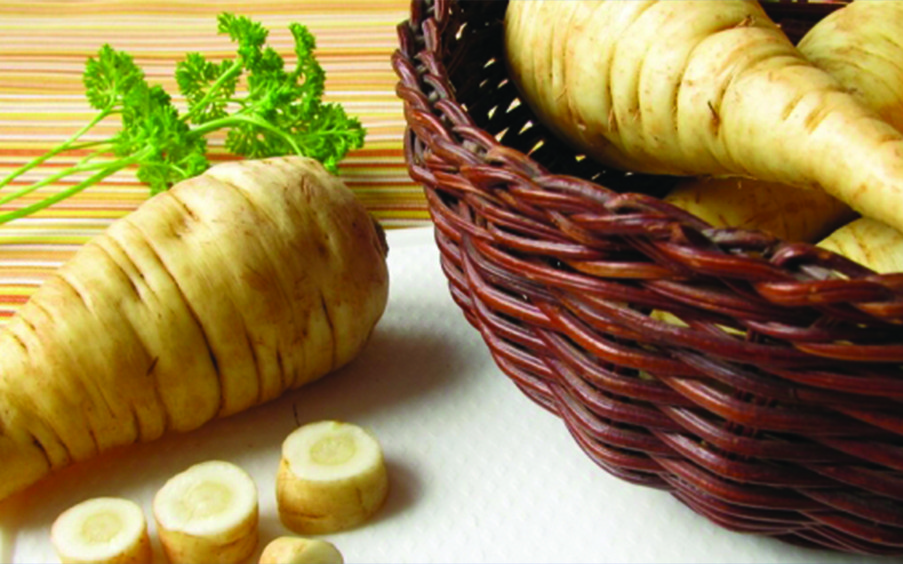Break out of your routine and experiment with new foods. In season now, these five vegetables make a fun and versatile departure from their more pedestrian cousins. Here’s how to pick the best of the bunch, keep them fresh and prepare them for tasty, healthy meals everyone can enjoy.
PURPLE POTATOES

BUY IT: Pick potatoes that are firm and have clean, smooth skin, with no bruises or cuts and few eyes. A potato that has been exposed to too much light will turn green, a result of builtup solanine, which tastes bitter and can cause illness. Take them home in a small brown paper bag rather than plastic.
STORE IT: Don’t store potatoes in the fridge. Cold temperatures turn the starch to sugar. Leave them in the paper bag and store them in a dark, dry place until you’re ready to wash and immediately use them; moisture speeds decay.
PREP IT: Purple tubers will hold up to almost any prep method, but roasting brings out their creamy and slightly nutty flavor. Scrub them under cold water and leave the skins on to get all the nutrients. Slice them into quarter-inch rounds or chunks, drizzle with extra virgin olive oil, season with kosher salt and rosemary, and roast them at 400 degrees for 15 to 20 minutes.
PARSNIPS

BUY IT: Select parsnips that are firm, unblemished and free of soft spots. Opt for small to medium roots, as the bigger ones tend to have a woody core.
STORE IT: If parsnips were under a mister at the market, wipe them dry and store them in a plastic bag in the refrigerator. They’ll keep for two to three weeks.
PREP IT: Wash and peel parsnips immediately before using them. They can be chopped or shredded and served raw on salads or as garnish, but one of the best ways to bring out their flavor is to roast them with potatoes and carrots. Or for a beautiful garnish, create a puree from the parsnip and serve under seared scallops or other seafood.
JICAMA

delectable paired with citrus fruits and seafood.
BUY IT: Choose firm, medium-sized bulbs with blemish-free skins. A bulb can weigh up to 3 pounds and should feel heavy for its size. Avoid the very large bulbs as they tend to lose their crispness and have a tougher texture.
STORE IT: Uncut, jicama will last up to two weeks when refrigerated. Once you’ve cut into it to expose the flesh, wrap it in plastic wrap and refrigerate for up to a week.
PREP IT: The skin is too thick to remove with a conventional vegetable peeler. Instead, use a paring knife to slice the skin off in sections. Slice or grate raw jicama and add it to winter salads, or combine it with cucumber or cabbage for a sweet and refreshing slaw.
KALE

BUY IT: The darker and firmer the leaves, the better. Steer clear of brown or yellow leaves or any that are wilting or full of holes.
STORE IT: At home, place unwashed kale in a large Ziploc bag. If it was under a mister at the store, shake off as much water as possible first. You can also place a paper towel in the bag to soak up extra moisture. Store in the refrigerator for up to five days.
PREP IT: Kale can be eaten raw, sautéed, boiled or steamed without losing nutrients. Remove the center stalk and vein and use the loose leafs in salads or soups as you would spinach. For a healthy indulgence, make a batch of kale chips. Tear the leaves into bitesize pieces, drizzle with olive oil, sprinkle with sea salt and bake at 350 degrees until crisp.
PERSIMMONS

BUY IT: Select persimmons with shiny, bright yellow or orange skin free from bruises or blemishes. They should be firm but not hard to the touch. The astringent variety—darker orange-ish red with pointy bottoms—shouldn’t be eaten until they’re completely ripe and soft to the touch.
STORE IT: Orange fuyus should be stored at room temperature, especially once ripe, and will last only a few days. The darker astringent variety, however, can survive a month or more when refrigerated.
PREP IT: At their peak, fuyu persimmons are delicious raw or cooked, and can be added to fruit or vegetable dishes. Or you can incorporate the pulp of the fruit into baked goodies such as oatmeal cookies and pancakes.

